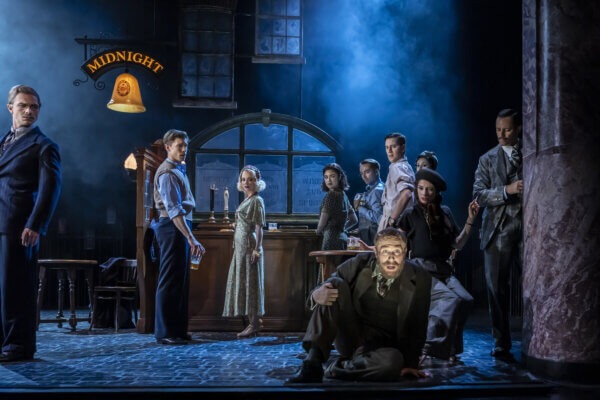Director and Choreographer: Matthew Bourne
Composer: Terry Davies
Matthew Bourne’s The Midnight Bell is a remarkable dance theatre production that draws inspiration from the writings of Patrick Hamilton, particularly his 1929 novel of the same name. Premiering in 2021, this captivating work explores the lives of ordinary individuals navigating the complexities of love, loss, and societal struggles in 1930s London. Set against the backdrop of Soho and Fitzrovia’s pubs and streets, Bourne’s choreography poignantly illustrates the emotional tapestry woven into Hamilton’s narratives.
The production has garnered widespread acclaim, culminating in Matthew Bourne receiving the National Dance Award for Best Modern Choreography. Sir Matthew Christopher Bourne OBE, born on 13 January 1960, is renowned as a British choreographer whose innovative approach often intertwines classic cinema and popular culture references with thematic elements drawn from musicals and film noir. His adaptations are distinctly unique; while they may be based on popular novels and films, they stand apart as original works of art.

Bourne’s creative process frequently involves workshops and collaboration that facilitate an ongoing dialogue with the source material. For instance, his acclaimed reimagining of Cinderella in 1997 drew upon Victorian and Edwardian literature to enrich its narrative depth. Similarly, his adaptations – ranging from Sleeping Beauty to Edward Scissorhands, The Red Shoes, Dorian Gray, and Lord of the Flies – have introduced fresh perspectives to these well-known stories.
The Midnight Bell exemplifies Bourne’s ability to infuse new life into classic literature by situating it within a contemporary context while remaining faithful to its thematic essence. Furthermore, his recent work on Romeo and Juliet has highlighted pressing issues such as mental health and youth suicide, demonstrating Bourne’s commitment not only to artistic innovation but also to social relevance within his choreographic explorations. Through these endeavours, Bourne continues to redefine dance theatre for modern audiences while paying homage to its rich literary roots.
This is a stunning production which captures the atmosphere and mood of 1930s London in a romantic, dangerous, and captivating perfection. The costume design by Lez Brotherston deserves high praise as he adeptly depicts the tightness and tidiness of 1930s fashion while still allowing the dancers full movement. Each garment reflects the era’s elegance, enhancing the overall aesthetic without compromising performance.
The dark, dank lighting design by Paule Constable further enriches this experience, providing just the right balance between joy and seediness that is essential to convey the story’s depth. The seamless transitions from scene to scene are achieved without jolting blackouts, allowing for an immersive journey through this evocative time period.
The dancers exhibit clarity in their performances, showcasing incredible talent and charisma that is completely captivating and mesmerising. They navigate the complexities of human emotion with grace, embodying both joy and tragedy. This duality gives us something to love and something to hate about each character in every moment.
The most powerful relationship within the narrative is portrayed by Liam Mower and Edwin Ray. Their performance encapsulates the complexities of a homosexual relationship developing within the confines of a pub, set against a backdrop where such acts were illegal in the UK, both in private and public spheres.
Mower and Ray deliver a sensational portrayal of their characters’ desperation to be together while navigating the societal constraints that compel them to keep their relationship concealed. The actors exhibit remarkable chemistry, effectively conveying the emotional turmoil associated with their clandestine love.
A particularly noteworthy aspect of their relationship is the meticulous attention to detail regarding flagging – a colour-coded system used by individuals to communicate their sexual preferences and find partners discreetly. This element adds depth to their story, highlighting not only the challenges faced by those in similar circumstances but also fostering a sense of community among individuals sharing comparable experiences. Such nuances are poignantly woven into their narrative, enhancing its authenticity and impact within the broader context of societal attitudes towards homosexuality during that era.
However, one notable downside is Bourne’s use of lip-synching, which feels overused in certain instances. What begins as an amusing conceit occasionally becomes heavy-handed; thus it could have benefitted from moderation or additional movement to enhance its impact. Overall, while this aspect detracts slightly from an otherwise exceptional production, it does not overshadow the remarkable artistry on display throughout.
Overall, Matthew Bourne has done another superb job with his dancers, weaving a tapestry of movement that truly captivates the audience. The way he brings to life such an intriguing story is nothing short of magical. Each performance is a testament to his visionary choreography, allowing the dancers to express emotions and narratives in ways that words simply cannot capture. The seamless blend of artistry and athleticism leaves spectators in awe, as they witness the profound connection between the performers and the story being told. It’s a remarkable experience that reaffirms Bourne’s status as a master of contemporary dance, pushing boundaries and inviting us into a world where every leap, turn, and gesture tells its own compelling tale.
Runs until 7th June 2025

